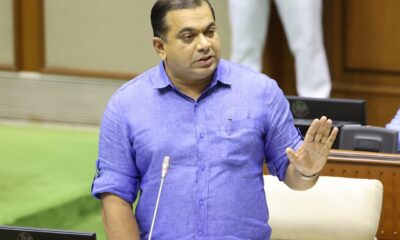Published
11 months agoon
By
goaplusnews
The Goa government, led by Chief Minister Pramod Sawant and Forest Minister Vishwajit Rane, has been at odds over the issue of designating the Mhadei Wildlife Sanctuary as a tiger reserve. Despite a court order from the Goa bench of the Bombay High Court directing the government to notify the sanctuary and its surrounding areas as a tiger reserve within three months, the state government has refused to comply.
There are multiple dimensions to this situation – both environmental and political. The constituencies within the sanctuary’s boundaries are represented by Sawant and Rane, both from the BJP. Despite their political differences, they appear united in their stance against designating the sanctuary as a tiger reserve.
Sawant initially supported the idea of a tiger reserve in the Mhadei area in 2020, but he now argues that Goa doesn’t meet the criteria set by the National Tiger Conservation Authority (NTCA) for establishing tiger reserves. He asserts that Goa has seven wildlife sanctuaries and will focus on protecting and conserving them within the guidelines of the Wildlife Act.
Rane, on the other hand, claims that designating the area as a tiger reserve would negatively impact the lives of people in the region. He stands against the tiger reserve order and intends to seek the assistance of the Union Ministry of Environment and Forests to maintain this stance.
The disagreement between the politicians and the court order raises concerns about the potential influence of mining interests and eco-tourism plans within the sanctuary. Environmentalists like Rajendra Kerkar believe that the government’s reluctance is tied to these economic interests, including plans for wildlife safaris and cottage construction within the sanctuary.
The Bombay High Court’s order emphasizes the significance of tiger conservation for maintaining a balanced ecosystem. The court directed the Goa government to prepare a tiger conservation plan and forward it to the NTCA within three months of notifying the tiger reserve. The court also stressed the need for anti-poaching measures, deploying forest guards, and addressing the rights of Scheduled Tribes and forest dwellers in the region.
The Goa government is challenging the High Court order in the Supreme Court, claiming that there is no proper recommendation from the NTCA for the establishment of a tiger reserve. The government is asserting that certain letters written by officers do not constitute a formal recommendation.
This isn’t the first time the issue of designating the Mhadei Wildlife Sanctuary as a tiger reserve has arisen. Past Union Ministers and environmentalists have also pushed for its designation due to its significance in the tiger corridor spanning Goa, Karnataka, and Maharashtra.
In light of decreasing tiger populations in specific regions of India due to habitat loss, fragmentation, and poaching, the Mhadei Wildlife Sanctuary’s potential as a tiger reserve holds importance for the conservation of this endangered species.


MLA Sankalp Amonkar Urges Action on Agriculture, Civil Supplies, and Handicrafts in Assembly Demands


CSC Diwas Celebrates 15 Years by Honoring VLE Excellence


MLA Borkar Flags Soaring Unemployment in Goa, Demands Overhaul of Employment Exchange Act


Manipal Hospital Performs Life-changing Restorative Surgery Saves Hand of a resident of Sawantwadi


The all-new BMW CE 04: First premium electric two-wheeler in India.


After Due Repairs, Public Toilets At Vagator will be Functional: TM Khaunte










